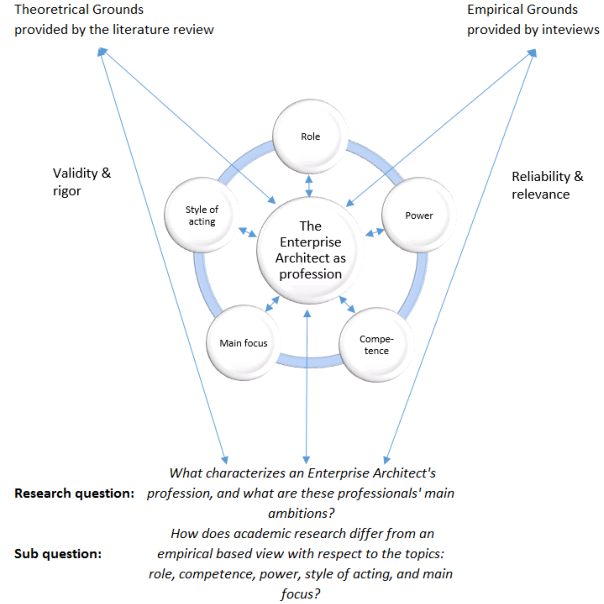

The Enterprise Architect – the Research Model
The previous sections of chapter 3 have been intended to position the Enterprise Architect profession in their contextual environment. However, this chapter is covering the central part of this research’s theoretical framework and the model for this study, which has the focal point of the Enterprise Architect. The theoretical framework presented in this section is intended as the section to which this study’s chapters of analysis, discussions, and summary are reflecting and relating to. When studying a profession, several approaches are available. This research’s aim is to portraying a broad picture of the Enterprise Architect’s profession, elucidated from five dimensions. This section depicts the Enterprise Architect from five dimensions as the research model of this study. Figure 1. The model for research. The model for research describes how the research questions have been processed in relation to the previous studies of the paper 1 and paper 2. To create a model for the empirical study, the study group conducted an initial and dedicated literature study concerning the Enterprise Architect profession (Besker & Olsson, 2014a). This study resulted in five different topics that were identified as particularly interesting. The literature was organized and categorized around these topics. A conceptual framework in the form of a research model was created providing a visual representation of theoretical constructs of interest, see figure 10. Questions and objectives based on the research model provide the foundation for the empirical part of the study (Besker & Olsson, 2015b). The research model defines the characteristics of the Enterprise Architect profession in five basic topics of interests. They are: (1) the role, (2) the competence, (3) the power, (4) style of acting, (5) main focus. The selected topics are illustrated by a conceptual research model, from Kerlinger’s (1979) recommendation; “Theories present a systematic view of phenomena by specifying relations among variables using a set of interrelated constructs/variables, definitions and propositions” (p. 82).The Enterprise Architect - Research Model
External links:
Rolf Olsson | ITM-Studier | Tingens internet (internet of things) | Affärsnyttan
© Enterprise Architect, 2015.
Version 0.27, 2015-10-11
Page references:
Besker, T., & Olsson, R. (2014). The Enterprise Architect profession: A literature survey. Department of Applied Information Technology. Chalmers University of
Technology and University of Gothenburg. Gothenburg.
Besker, T., & Olsson, R. (2015). The Enterprise Architect profession: An empirical study. Department of Applied Information Technology. Chalmers University of
Technology and University of Gothenburg. Gothenburg.
Kerlinger, F. N. (1979). Behavioral research: a conceptual approach. New York: Holt.


























